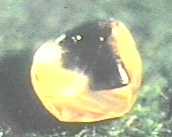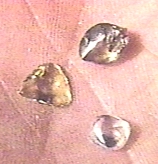

|
Once upon a time, a long, long time ago, a volcano erupted in what is now southwest Arkansas, bringing to the surface lots of diamonds! Now anyone can go to this eroded volcanic pipe and look for diamonds and the best thing is, you get to keep what you find!. It only costs $4.50 a day to access the 35 acre site, located near Murfreesboro, about a 3 hour drive south of Alma. On Tuesday, April 7th, 1998, two women were surface searching and they found a 7.28 carat yellow diamond. It is the 5th largest diamond to be found at the park since it became a state park in 1972. Beth and I have been several times and so far we haven't found a diamond but we will. I just know it. Next time, perhaps. The following information is from a brochure that is available at the park. Diamonds have an oily, slick outer surface that dirt and mud will not stick to, so look for clean crystals. Diamonds are extremely hard crystals that will not scratch or crush when pressures is applied to them (i.e. with a fingernail or pocketknife). Don’t be scared to test your minerals in this way. A diamond will not be harmed. The three most common diamond colors at the Crater are white, yellow, and brown. Bring any stone that you think might be a diamond to the Visitor Center for free verification. All diamonds are weighed and certified free of charge. And remember, any diamond, rock, or mineral that you find is yours to keep. Screening-Putting the soil through a screen to find minerals that are too large to fit through the mesh. This method is most effective when the soil is dry. Wet Screening-Using water available on the mine to wash dirt through a screeen to see what minerals are left behind. Remember, diamonds do not run in veins like gold but are spread through-out the greenish lamproite soil. Plants, animals, and historic resources are protected here as in all state parks. If you uncover man-made objects, please notify the park staff. You may search only in the open field within the yellow boundary markers. You may use any tool to search for diamonds as long as it does not have wheels or a motor. Any hole that you dig, you must fill in before leaving the same day. Any hole deeper than 4 feet must be shored up properly. Each visitor may remove two handfuls of unprocessed lamproite and /or one 5 gallon bucket of washed gravel per day. A complete list of other park rules is available at the vistor information desk. Agate- Much like jasper, agate usually has banded layers. It can be cut with a rock saw to show the beautiful patterns inside. Fairly common on the field. Quartz- The Quartz found here is usually grain to pebble-sized. It shows sharp, angular faces, and the crystal surface almost always has a series of parallel lines that can be seen with the unaided eye. Fairly common on the field. Amethyst- basically, purple quartz. Not common, but present on the field. Calcite- This is one of the most common minerals on the mine. It is a milky white mineral that forms many crystal shapes. Calcite is soft and scratches easily with a fingernail or steel. Barite- Commonly a light sky blue, barite forms in many different colors. Much like calcite, barite will scratch and break apart very easily. It is common on the field. Mica- Those tiny, shiny flecks that you see everywhere on the field are commonly called “fools gold.” It occurs at the Crater as the small brass yellow or coppery metallic looking crystals found in the lamproite. Lamproite- This is volcanic soil that makes up the field. This mineral will often be found in rock of colors, including green, black, and white. Lamproite will ususally crumble and break apart very easily. Crater of Diamonds State Park GORP link Crater of Diamonds State Park Arkansas State Parks link
|   Before-16 carats,37 points
Before-16 carats,37 points
|